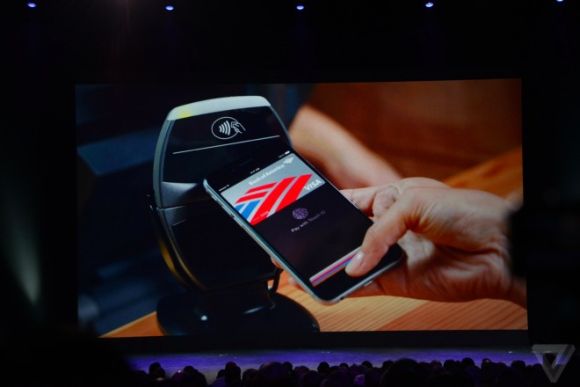The other big thing at the Apple announcement this morning was mobile payments. During his presentation, Tim Cook boasts that the new Apple Pay service, that’s integrated into the iPhone 6 and iPhone 6 Plus, “will forever change the way we buy”, but does it really?
Mobile payments have been slow to catch on. Despite the massive push from banks, credit card companies and even some of the biggest tech brands in the world, adoption has been slow. Many are saying Apple’s mobile pay solution will be the catalyst the industry needs for mass adoption but we’re not convinced.
Using NFC, Apple Pay is designed to allow users to make a purchase — for merchandise, tickets, meals, etc. — by simply waving their iPhone in front of a scanner. The advantage of Apple Pay, the company claims, is faster payments, more convenience and better security. Apple claims any transaction made using Apple Pay is between the user, the merchant and the bank, Apple doesn’t have access to the information nor does it share that information with anyone else. To enter a credit card information, you simply take a picture of you card using your iPhone and Apple Pay will do the rest. At launch, the Apple Pay service will work with cards issued in the US at merchants in the US as well. Apple did not say when or if the service will be available in other countries.
So that begs the question, will Apple Pay change the way we shop? Not in Malaysia, not in the near future at least. The problem lies in Apple Pay’s dependence on an iPhone or an Apple Watch to work. While Apple is a well-known brand here in Malaysia, the smartphone market is dominated by Samsung and other Android manufacturers, and unless Apple decides to make really cheap iPhones, majority of Malaysians are not going to switch to an iPhone just because of Apple Pay.
Which leads us to the other issue with Apple Pay, adoption. According to Malaysian Electronic Clearing Corporation, MyClear, there are 38 million mobile phones in the country yet there are only 2.44 million mobile banking subscribers as of 2012. That’s a penetration rate of just 8%, which, in some respects, is an indication of our apprehension when it comes to doing banking with our mobile phones.
Locally Maxis has tried to venture in mobile payment several years ago with its FastTap service which uses Maybank Visa Wave and TouchnGo terminals. That didn’t last long as it was restricted to a single NFC enabled Nokia model at that time. Later on, Maxis was supposed to offer mobile payments on the iPhone in collaboration with CIMB and TouchnGo but that didn’t fly as well.
Even in the US, experts are predicting that it could take up to a decade before we can see significant market penetration of NFC payment services like (but not exclusive to) Apply Pay. Even then traditional payment methods will still be the norm.
In fact, according to a new study taken over the weekend by CreditCards.com, paying by phone didn’t appeal to nearly two-thirds of Americans.
In the survey, 44% of respondents said they would never use their phone to pay for items. Only 4% said they would always use theirs, and just 9% said they would use it most of the time. The survey of 1,003 people, conducted Sept. 4-7, has a margin of error of 3.6 percentage points.
Adopting Apple Pay will also mean additional investment on the merchants and banks but with such a low adoption rate and a high entry barrier for users (who have to invest in an iPhone to be able to use Apple Pay) will we see people waving their iPhones about to pay for their next teh tarik? At the rate things are going, it’s unlikely.







